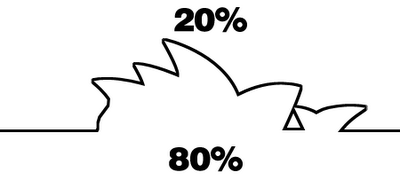A recent post from anArchitecture mentioned the Pareto Principle – also known as the 80/20 rule. The idea, as explained on the site: “The 80/20 rule asserts that approximately 80% of the effects generated by any large system are caused by 20% of the variables in that system. The 80/20 rule is observed in all large systems, including those in economics, management, interface design, engineeing, etc.”

:: image via anArchitecture
I stumbled upon the idea of the Pareto Principal a few years back, when researching the economic benefits of green building to present cost-benefit analysis findings to developers and other clients. While looking at this from a design perspective seems a bit more vague – the 80/20 rule seems to fit well into ideas of sustainable strategies. While not quantified specifically using any rational or mathematical means – it’s most useful aspect is to provide a compelling conceptual framework to envision why certain strategies rise above others from a cost perspective.
Applied to landscape architecture – it holds as so… 80% of the sustainability gains are achieved through 20% of the potential strategies. For instance, the cost of a strategy that is more attainable and affordable on a site with plenty of available area, like stormwater planters or wetland ponds — make more sense than the pricier strategies, like permeable paving or green roofs – which may provide less benefit for cost invested. Obviously this is site dependent – and can’t provide a consistent guide (i.e. it still requires expertise, analysis, and design) to certain strategies over others.
We prepared a study that used this rough approach to develop scenarios for an urban site. For starters – the using a range of options: ecoroofs, stormwater planters, swales, ponds, vegetated filter strips, permeable paving, and barring other methods, mechanical filtration systems. The study consisted of three scenarios:
1. The first scenario provided a baseline for standard design and engineering design – looking at a system of drains, pipes, and water quantity and quality handled through predominately mechanical means. This also included a cost of basic amenity landscaping for a site of this type. (Cost Factor = 1.0)
2. The second scenario applied every possible strategy in every possible location – with an end goal of eliminating pipe infrastructure completely from the project. The goal of removal of pipe was attained, but the significant cost increase made this not beneficial or reasonable for the project. (Cost Factor = 3.2)
3. The final scenario used a cost/benefit – using an 80/20 rule – where selected benefits of strategies were weighted against the costs specific to this site. By selectively taking advantage of the assets and opportunties on site – and using them in inventive ways to solve stormwater problems – the project goals were met, and cost was actually decreased. (Cost Factor = 0.9)
The other intangible benefit is the increase in amenity over the base case. While the amount of landscaping was adequate – the idea of multi-functional landscaping – which provided stormwater management, amenity, and code landscaping – both increased overall landscaping as well as saved money but providing visible and efficient use of the site area. Items such as permeable paving, aside from achieving sustainable goals, add amenity over typical concrete or asphalt paving – especially for accent and parking areas – articulating the site and providing beneficial design opportunities.
So imagine presenting ideas to a developer about the design that meets project goals, with lower costs, and increased amenities (read: marketability) of the site… saving money and increasing saleability. Thank you, Mr. Pareto.
anArchitecture posits the 80/20 rule and it’s potential usefulness in architecture from a design perspective. I guess it’s questionable how quantifiable this is – as the examples of 20% of design decisions impacting 80% of results. I actually like the idea of one of the post comments: “One could argue that 80% of a proposed architectural solution is already given by the surrounding contextual forces, and the architect only needs to provide the remaining 20% to complete it.”
This has some interesting ideas for contextual design… and perhaps even from the site and immediate physical context. I guess it depends on what you mean by ‘surrounding contextual forces’ – so in lieu of other input – I consider this urban fabric, site, landscape – and social forces. Obviously there are a number of other inputs – economics, existing stylistic preference, material availability… but for the most part – it really starts to limit the hand of the architect…
…or, we can thinking of it as focusing it more. The act of design is one of identifying and making decisions and narrowing the focus to the essential elements that make a project unique and successful. Too many choices – and the design can be artistic – but lack the connection to place and purpose. Too few choices – and the design will be constrained by. It’s again a question of art (lacking purpose) and function (lacking poetry). So some methodology is important to allow for a consistent amount of focus. By selectively utilizing 20% of available options – and achieving 80% of gains – it provides a modicum of restraint, and still offers a range of design options and artistic opportunities.
Another interesting idea to throw around – maybe from a more abstract business sense, from Wikipedia: “The Pareto principle was a prominent part of the 2007 bestseller The 4-Hour Workweek by Tim Ferriss. Ferriss recommended firing the 80% of your customers who take up the majority of your time and focusing on the 20% who make up the majority of your profits.”